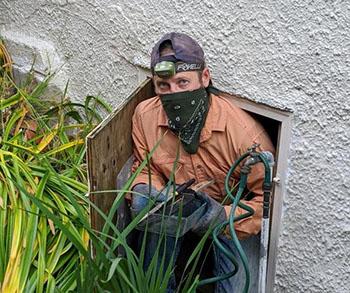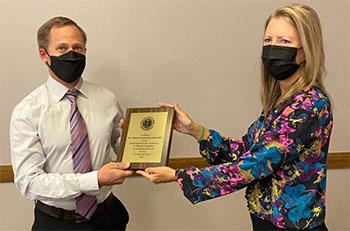Summer 2022
Integrated Pest Management (IPM)

by David George
The parent organization of the Master Gardeners of Contra Costa County, the UC Cooperative Extension (UCCE), includes county-based applied researchers in many fields related to agriculture and natural resources. One of our local Cooperative Extension faculty members, Dr. Andrew Sutherland, the SF Bay Area Urban Integrated Pest Management (IPM) Advisor, participates in several nationwide certification programs for pest control professionals and researchers. These are administrated by the Entomological Society of America’s (ESA) Certification Corporation Board (CCB).
Dr. Sutherland, recent past director of the CCB, was recently recognized for exceptional service to the ESA for his role in development of a new certification program for entry-level pest management professionals.
I interviewed Andrew about what this means to pest management professionals and to the safety of the general public:
How did you get involved in entomology, pest management, and the UCCE program, Andrew?
“I took an interesting, convoluted path to my current position within UCCE and the ESA CCB. I was a youngster in the Florida landscape nursery industry, struggling to find a career path when I took a pest management course and was inspired by a University of Florida Extension agent to get an undergraduate degree in environmental horticulture. After my BS in Environmental Horticulture at U. of Florida, I earned my PhD in entomology at UC Davis in 2009. I joined the UCCE program in 2012 as an urban pest management advisor, focusing on urban insect pests and working closely with the pest control industry.”
What is the problem that your new certification program addresses?
“Before my tenure, the certification board had developed several professional certification programs, starting with the Board Certified Entomologist (BCE) credential. To enter the BCE program, you must have earned a higher degree (BS, MS, or PhD) in entomology and have worked professionally in a related field for 1-3 years following degree attainment.
"These are tough prerequisites for most pest professionals. So, the Board developed the Associate Certified Entomologist (ACE) credential for pest professionals in the US who have worked in the industry for at least five years, who hold a pesticide applicator license, and who pass a rigorous test focused on safety practices and structural pest control knowledge. But what if you’re just starting on this career path? Companies and residents have a need to know that technicians who perform their service will utilize safe and effective pest management techniques as advocated by our IPM strategies and best practices. These are the body of entry-level professionals that the new certification program, the Certified IPM Technician (CIT), targets.”
“First of all, tested knowledge expectations regarding the steps and components of Integrated Pest Management (IPM). The targeted technician works in the structural pest control industry but doesn’t necessarily have a college degree or 5+ years of experience. They demonstrate their eagerness to follow IPM best practices, launching them on a career path toward an ACE credential.
"The course content is roughly 25% inspection and monitoring, 25% pest identification, 20% of proper selection control methods, 20% follow-up evaluation protocols, and 10% documentation and reporting. This new certification program has received considerable interest so far and great industry reviews.”
What are the most important benefits?
“The new program is holistically and deeply grounded in IPM, focusing on best practices that should be a way of life for both new and seasoned pest professionals. These folks are out there every day, balancing the benefits of ridding a home or business of pests with providing an environmentally safe solution.
"Pest control customers should learn about these certificates and ask for certified technicians when they call for service. If certified, they can feel confident that their technician is using methods consistent with IPM recommendations. For example, rodent management may focus on exclusion and trapping rather than use of poison baits. We all know that IPM is a best practices approach that minimizes the use of toxic pesticides in our homes and gardens. We’re working hard to ensure the public’s safety through rigorous professional certification.”
Article by David George, UC Master Gardener of Contra Costa County
Photo credits: Casey Hubble and Chris Stelzig
